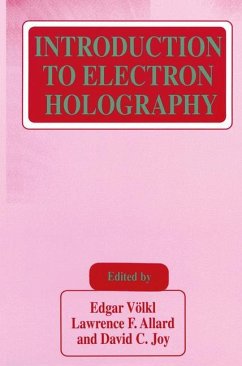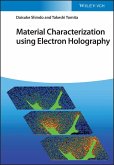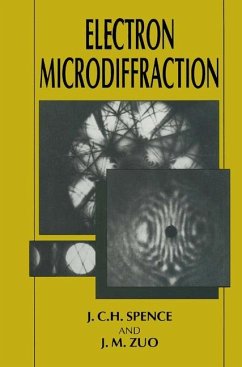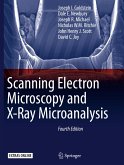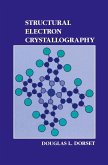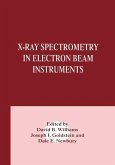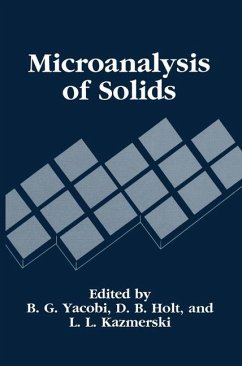Introduction to Electron Holography
Herausgegeben:Völkl, Edgar; Allard, Lawrence F.; Joy, David C.
Introduction to Electron Holography
Herausgegeben:Völkl, Edgar; Allard, Lawrence F.; Joy, David C.
- Broschiertes Buch
- Merkliste
- Auf die Merkliste
- Bewerten Bewerten
- Teilen
- Produkt teilen
- Produkterinnerung
- Produkterinnerung
Experienced and novice holographers receive a solid foundation in the theory and practice of holography, the next generation of imaging technology, in this superb text. The book's `how to' aspects enable readers to learn hologram acquisition at the microscope and processing of holograms at the computer as well as digital imaging techniques. A complete bibliography on electron holography and applications of the method to problems in materials science, physics and the life sciences round out the volume's coverage.
Andere Kunden interessierten sich auch für
![Material Characterization using Electron Holography Material Characterization using Electron Holography]() Daisuke ShindoMaterial Characterization using Electron Holography153,81 €
Daisuke ShindoMaterial Characterization using Electron Holography153,81 €![Electron Microdiffraction Electron Microdiffraction]() J. M. ZuoElectron Microdiffraction115,99 €
J. M. ZuoElectron Microdiffraction115,99 €![Scanning Electron Microscopy and X-Ray Microanalysis Scanning Electron Microscopy and X-Ray Microanalysis]() Joseph I. GoldsteinScanning Electron Microscopy and X-Ray Microanalysis83,99 €
Joseph I. GoldsteinScanning Electron Microscopy and X-Ray Microanalysis83,99 €![Structural Electron Crystallography Structural Electron Crystallography]() D. L. DorsetStructural Electron Crystallography112,99 €
D. L. DorsetStructural Electron Crystallography112,99 €![Cathodoluminescence Microscopy of Inorganic Solids Cathodoluminescence Microscopy of Inorganic Solids]() B. G. YacobiCathodoluminescence Microscopy of Inorganic Solids115,99 €
B. G. YacobiCathodoluminescence Microscopy of Inorganic Solids115,99 €![X-Ray Spectrometry in Electron Beam Instruments X-Ray Spectrometry in Electron Beam Instruments]() X-Ray Spectrometry in Electron Beam Instruments153,99 €
X-Ray Spectrometry in Electron Beam Instruments153,99 €![Microanalysis of Solids Microanalysis of Solids]() Microanalysis of Solids149,99 €
Microanalysis of Solids149,99 €-
-
-
Experienced and novice holographers receive a solid foundation in the theory and practice of holography, the next generation of imaging technology, in this superb text. The book's `how to' aspects enable readers to learn hologram acquisition at the microscope and processing of holograms at the computer as well as digital imaging techniques. A complete bibliography on electron holography and applications of the method to problems in materials science, physics and the life sciences round out the volume's coverage.
Produktdetails
- Produktdetails
- Verlag: Springer / Springer US / Springer, Berlin
- Artikelnr. des Verlages: 978-1-4613-7183-0
- 1999
- Seitenzahl: 376
- Erscheinungstermin: 23. Oktober 2012
- Englisch
- Abmessung: 235mm x 155mm x 21mm
- Gewicht: 568g
- ISBN-13: 9781461371830
- ISBN-10: 146137183X
- Artikelnr.: 40734748
- Herstellerkennzeichnung
- Springer-Verlag GmbH
- Tiergartenstr. 17
- 69121 Heidelberg
- ProductSafety@springernature.com
- Verlag: Springer / Springer US / Springer, Berlin
- Artikelnr. des Verlages: 978-1-4613-7183-0
- 1999
- Seitenzahl: 376
- Erscheinungstermin: 23. Oktober 2012
- Englisch
- Abmessung: 235mm x 155mm x 21mm
- Gewicht: 568g
- ISBN-13: 9781461371830
- ISBN-10: 146137183X
- Artikelnr.: 40734748
- Herstellerkennzeichnung
- Springer-Verlag GmbH
- Tiergartenstr. 17
- 69121 Heidelberg
- ProductSafety@springernature.com
1 The History of the Electron Biprism.- 1 The beginning.- 2 The first interferometer.- 3 The biprism idea.- 4 Biprism design and 1st experiments.- 5 Further Tübingen experiments.- 2 Principles and Theory of Electron Holography.- 1 Introduction.- 2 Imaging theory.- 3 In-line point-projection holography.- 4 In-line TEM holography.- 5 Off-axis TEM holography.- 6 Off-axis holography in a STEM instrument.- 7 Theoretical formulations for other modes.- 8 Interference in diffraction patterns and holographic diffraction.- 9 Application to the study of magnetic and electric fields.- 10 Studies of surface structure.- 11 Discussion.- 3 Optical Characteristics of an Holography Electron Microscope.- 1 Introduction.- 2 Brightness.- 3 Coherence and contrast transfer.- 4 Illumination geometry.- 5 Isoplanatism and coma.- 6 Contrast transfer considerations in the field emission microscope.- 7 Standard criterion for microscopes for holography.- 8 Conclusion.- 4 Practical Electron Holography.- 1 Introduction.- 2 Setting up the instrument.- 3 Recording holograms.- 4 Important parameters.- 5 Further considerations.- 6 Conclusion.- 5 Quantitative Electron Holography.- 1 Introduction.- 2 Electron detectors.- 3 Characteristics of CCD cameras.- 4 Factors affecting detection limits.- 5 Applications of quantitative electron holography.- 6 The Reconstruction of Off-Axis Electron Holograms.- 1 Introduction.- 2 Basic reconstruction process.- 3 Minimizing the effects of sampling.- 4 Lens aberrations: Distortions.- 5 The reconstruction process using a reference hologram.- 6 Other reconstruction methods.- 7 Methods for lower carrier frequencies.- 8 Display of phase information.- 7 Electron Holography of Electromagnetic Fields.- 1 Introduction.- 2 Theory.- 3 Holographic electron microscope forsuperconductivity investigations.- 4 Observation of fluxons in superconductors.- 5 Lorentz observations.- 6 Higher resolution holography.- 7 Conclusions.- 8 On Recording, Processing And Interpretation Of Low Magnification Electron Holograms.- 1 Introduction.- 2 General considerations on the electron phase.- 3 Centering the sideband.- 4 Quantification of magnetic and electric fields.- 5 Distinguishing magnetic and electric fields.- 6 Dislocations in a hologram.- 9 High Resolution Off-Axis Electron Holography.- 1 Introduction.- 2 Wave optical imaging in HRTEM.- 3 Off-axis electron holography: Principle.- 4 Correction of aberrations.- 5 Optimizing the parameters for high resolution electron holography.- 6 Practical examples.- 7 Conclusion.- 10 Off-Axis Stem Holography.- 1 Introduction.- 2 Hologram formation and reconstruction schemes.- 3 Experimental considerations.- 4 Accuracy of phase measurement.- 5 Application of special detectors.- 6 Far-out-of-focus off-axis STEM holography: Application to magnetic materials.- 7 Optimum conditions for high resolution imaging.- 8 Correction of lens aberrations.- 9 Conclusions.- 11 Focus Variation Electron Holography.- 1 Introduction.- 2 Image formation in a TEM.- 3 Least squares wave function reconstruction.- 4 Experimental results.- 5 Interpreting the reconstructed object wave.- 6 Validity of the channelling theory.- 7 Scaling.- 8 Other aspects of channelling.- 9 Results.- 10 Conclusions.- 12 Applications of Electron Holography.- 1 Introduction.- 2 Mean inner potential and its effects on phase images.- 3 Theoretical calculations of mean inner potential.- 4 Holographic experimental measurements of mean inner potential.- 5 Specimen thickness and its effects on phase and amplitude images.- 6 Applications of off-axis electron holographyto studies of interfaces.- 7 Applications of holography to surfaces.- 8 Applications of holography to fine particles.- 9 Conclusions.- 13 Electron Holography Using Diffracted Electron Beams (DBH).- 1 Introduction.- 2 Basic theoretical considerations.- 3 Analysis of the interference phenomena.- 4 Influence of coherence.- 5 The holography mode.- 6 Experimental method.- 7 Spherical aberration.- 8 Material science applications.- 9 Interesting perspectives.- 10 Conclusions.- 11 Appendix.- 14 Electron Holography at Low Energy.- 1 Introduction.- 2 Electron ranges in solids.- 3 Image formation and reconstruction.- 4 Nanotips.- 5 Instruments.- 6 Radiation damage.- 7 The reflection mode.- 8 Conclusions.- 15 A Plus or Minus Sign in the Fourier Transform?.
1 The History of the Electron Biprism.- 1 The beginning.- 2 The first interferometer.- 3 The biprism idea.- 4 Biprism design and 1st experiments.- 5 Further Tübingen experiments.- 2 Principles and Theory of Electron Holography.- 1 Introduction.- 2 Imaging theory.- 3 In-line point-projection holography.- 4 In-line TEM holography.- 5 Off-axis TEM holography.- 6 Off-axis holography in a STEM instrument.- 7 Theoretical formulations for other modes.- 8 Interference in diffraction patterns and holographic diffraction.- 9 Application to the study of magnetic and electric fields.- 10 Studies of surface structure.- 11 Discussion.- 3 Optical Characteristics of an Holography Electron Microscope.- 1 Introduction.- 2 Brightness.- 3 Coherence and contrast transfer.- 4 Illumination geometry.- 5 Isoplanatism and coma.- 6 Contrast transfer considerations in the field emission microscope.- 7 Standard criterion for microscopes for holography.- 8 Conclusion.- 4 Practical Electron Holography.- 1 Introduction.- 2 Setting up the instrument.- 3 Recording holograms.- 4 Important parameters.- 5 Further considerations.- 6 Conclusion.- 5 Quantitative Electron Holography.- 1 Introduction.- 2 Electron detectors.- 3 Characteristics of CCD cameras.- 4 Factors affecting detection limits.- 5 Applications of quantitative electron holography.- 6 The Reconstruction of Off-Axis Electron Holograms.- 1 Introduction.- 2 Basic reconstruction process.- 3 Minimizing the effects of sampling.- 4 Lens aberrations: Distortions.- 5 The reconstruction process using a reference hologram.- 6 Other reconstruction methods.- 7 Methods for lower carrier frequencies.- 8 Display of phase information.- 7 Electron Holography of Electromagnetic Fields.- 1 Introduction.- 2 Theory.- 3 Holographic electron microscope forsuperconductivity investigations.- 4 Observation of fluxons in superconductors.- 5 Lorentz observations.- 6 Higher resolution holography.- 7 Conclusions.- 8 On Recording, Processing And Interpretation Of Low Magnification Electron Holograms.- 1 Introduction.- 2 General considerations on the electron phase.- 3 Centering the sideband.- 4 Quantification of magnetic and electric fields.- 5 Distinguishing magnetic and electric fields.- 6 Dislocations in a hologram.- 9 High Resolution Off-Axis Electron Holography.- 1 Introduction.- 2 Wave optical imaging in HRTEM.- 3 Off-axis electron holography: Principle.- 4 Correction of aberrations.- 5 Optimizing the parameters for high resolution electron holography.- 6 Practical examples.- 7 Conclusion.- 10 Off-Axis Stem Holography.- 1 Introduction.- 2 Hologram formation and reconstruction schemes.- 3 Experimental considerations.- 4 Accuracy of phase measurement.- 5 Application of special detectors.- 6 Far-out-of-focus off-axis STEM holography: Application to magnetic materials.- 7 Optimum conditions for high resolution imaging.- 8 Correction of lens aberrations.- 9 Conclusions.- 11 Focus Variation Electron Holography.- 1 Introduction.- 2 Image formation in a TEM.- 3 Least squares wave function reconstruction.- 4 Experimental results.- 5 Interpreting the reconstructed object wave.- 6 Validity of the channelling theory.- 7 Scaling.- 8 Other aspects of channelling.- 9 Results.- 10 Conclusions.- 12 Applications of Electron Holography.- 1 Introduction.- 2 Mean inner potential and its effects on phase images.- 3 Theoretical calculations of mean inner potential.- 4 Holographic experimental measurements of mean inner potential.- 5 Specimen thickness and its effects on phase and amplitude images.- 6 Applications of off-axis electron holographyto studies of interfaces.- 7 Applications of holography to surfaces.- 8 Applications of holography to fine particles.- 9 Conclusions.- 13 Electron Holography Using Diffracted Electron Beams (DBH).- 1 Introduction.- 2 Basic theoretical considerations.- 3 Analysis of the interference phenomena.- 4 Influence of coherence.- 5 The holography mode.- 6 Experimental method.- 7 Spherical aberration.- 8 Material science applications.- 9 Interesting perspectives.- 10 Conclusions.- 11 Appendix.- 14 Electron Holography at Low Energy.- 1 Introduction.- 2 Electron ranges in solids.- 3 Image formation and reconstruction.- 4 Nanotips.- 5 Instruments.- 6 Radiation damage.- 7 The reflection mode.- 8 Conclusions.- 15 A Plus or Minus Sign in the Fourier Transform?.

